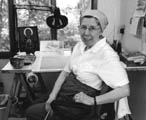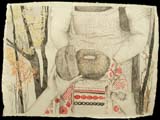janet hart heinicke 
indianola, iowa | interviewed 2-7-2002
biographical sketch | artist's statement | interview clips

"The Hospitality of Bread"
drawing
(click image for larger view)
copyright © 2001 Janet Hart Heinicke | All Rights Reserved
interview clips (mp3 audio & text)
I think, like many others, I was struck at how reality resembled unreality. The photograph of an airplane fly into the World Trade Center seemed unreal, as though it couldn't be reality. I have it in my head the image of the figures of people as they leaped from the building, [in] particular[], I thought the most startling image [was] of the man who had folded his arms across his chest and appeared to be in a kind of ballet-like pose as he almost pirouetted to earth. That's an image that's unforgettable for me.
I [have] found myself sort of in an odd posture—in the posture of watching the symbols of patriotism, and the language of patriotism everywhere, and being glad to see that. At the same time, sort of standing away from it, and thinking about the Muslims I knew from Malaysia, the good friends that I had met there. My sort of carefully-acquired little bits of knowledge about the religions of the world and the places of the world that were in the news. I'm thinking about those little bits of knowledge and [find myself] standing outside the events in our country, and [I am] trying to make some sense of that dissonance.
I'd been in a meeting over in Iowa City, and driving home, I was struck by the beauty again of the Iowa landscape, which is so serene, so unblemished. And I was hearing on my car radio the latest report of bombing in Afghanistan. I couldn't help but think to myself, we don't really know what we're doing. We don't have any way of understanding what this is. Here [we are in a ] land that has never been bombed, not to mention being bombed over and over and over again. I wanted to do something to sharpen that contrast. So I came home and took an old painting and laid over it, a graphite drawing. And on the right, is that sort of serene, cultivated, almost manicured land that is part of what Iowa is. And then on the other side, I drew a bombed landscape. That's one example of trying to make visual some things that I find difficult and in some ways a little frightening to articulate. Because to part of my head, that sounds very unpatriotic. To the other part of my intellect, I know it's true.
I think America is great because it is a democratic country. Democracy, in my opinion, is the greatest idea that human beings have ever had about how they should govern themselves. But it rests on the idea that the people are an informed electorate—that they find out about that government and that they are active participants in it. When democracy doesn't work, it is because the electorate is lazy, or uninformed.
I think we have had, prior to September 11th, and continue to have, some real challenges in making democracy an effective instrument. Our [democratic] country is larger; it is certainly more diverse. That doesn't mean that it is any less of a valid idea. It means that it is more challenging, I think, but more of a valid idea.
I believe making art has to do with revealing something of yourself, not with imitating what is popular or in the marketplace. I think each self is important and unique and different, and it takes a lifetime for an artist to discover what is in themselves that can be visually communicated. I think there's far too much willingness to be imitative, and not enough encouragement of saying to young people, Who you are is a wonderful and beautiful and unique person—let your art express that. Be yourself, because that's plenty good enough!
biographical sketch
Janet Hart Heinicke was born and raised in Richmond, Indiana. She is an only child.
She received her B.S. in Art Education from Wittenberg University in Springfield, Ohio, her M.S. in Art Education from the University of Wisconsin-Madison, and her M.F.A. in Painting and Ed.D. in Education Administration from Northern Illinois University in DeKalb, Illinois. She has taught art at Simpson College, Indianola, Iowa, for many years, and retired in August 2001 as Professor of Art, emeriti. She continues to teach, however, at Simpson.
Since 1992, she has traveled widely, including the Soviet Union, People's Republic of China, Malaysia, Latvia, Japan, Vietnam, Philippines, Cambodia, and Ukraine.
She is married and has five children, and lives in Indianola with her husband. Her artwork consists mostly of painting, drawing, collage, and mixed media.
artist's statement
The ideas I have been working with in fall 2001 and (now) winter 2002 have been simmering for a long time. During the last decade of the twentieth century and the present time I have been searching for a way to synthesize words, images, experiences into a nonverbal, visual whole. I had promised myself I would do it this year.
I traveled widely, visiting the former Soviet Union six times, and Malaysia an equal number of times. I spent prolonged periods as a visiting artist in Japan and, more recently, in the Ukraine. In March 2001 I saw the ruins of the twelfth century temple at Angkor War in Cambodia. I had a sketchbook full of drawings, a journal full of notes and ideas, photographs and partially developed drawings. Surely there must be a universality that would become apparent to this Iowan in foreign (and far away) places.
I kept returning to the words of an overweight Russian woman who, at a meeting of a woman's group in Stavropol Russia, reiterated a phrase I heard everywhere as new friendships blossomed, "We are more alike than different."
The events of September 11, 2001 brought alarm to this reverie. Was it pertinent, or even relevant, in the midst of patriotic fervor to think about, much less, express visually, the idea that, regardless of nationality or religion or even of politics that human beings are more alike than different? Did it matter any more to express in visual form the ideas of universality? I had found commonality between cultures, not differences. In the midst of flag waving and patriotic anthem singing was I being unpatriotic to try to do art about the universal desire to share the hospitality of bread, or the common desire to provide a "good time" for the stranger in our midst?
I concluded it was now more than ever important to emphasize the commonality of grief, or hospitality, of joy among all the peoples of this tiny planet we share.
The first piece I have done deals with the "Hospitality of Bread." Wherever we are, but most especially in Russia a warm, freshly baked loaf of bread signals a welcome that is centuries old. When wheat and salt were owned by the rich, a gift of bread and salt was a sign of rich welcome. It is centuries old. It remains, in its multiple forms (bagel, store bread, or home made bread done in the "bread maker machine" of American kitchens) a sign of warmth, home and welcome.



